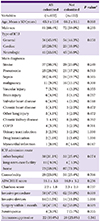1. Holmberg SD, Solomon SL, Blake PA. Health and economic impacts of antimicrobial resistance. Rev Infect Dis. 1987; 9:1065–1078.

2. Howard A, O’Donoghue M, Feeney A, Sleator RD.
Acinetobacter baumannii: an emerging opportunistic pathogen. Virulence. 2012; 3:243–250.
3. Peleg AY, Seifert H, Paterson DL.
Acinetobacter baumannii: emergence of a successful pathogen. Clin Microbiol Rev. 2008; 21:538–582.

4. Montefour K, Frieden J, Hurst S, Helmich C, Headley D, Martin M, Boyle DA.
Acinetobacter baumannii: an emerging multidrug-resistant pathogen in critical care. Crit Care Nurse. 2008; 28:15–25.

5. Young LS, Sabel AL, Price CS. Epidemiologic, clinical, and economic evaluation of an outbreak of clonal multidrug-resistant
Acinetobacter baumannii infection in a surgical intensive care unit. Infect Control Hosp Epidemiol. 2007; 28:1247–1254.

6. Kwak YG, Cho YK, Kim JY, Lee MS, Kim HY, Kim YK, Park ES, Jin HY, Kim HB, Kim ES, Jeong SY, Eom JS, Kim SR, Lee JY, Hong HK, Sung JH, Uh Y, Lee YS, Oh HB, Kim EC; Korean Nosocomial Infections Surveillance System (KONIS). Korean nosocomial infections surveillance system, intensive care unit module report: data summary from July 2009 through June 2010. Korean J Nosocomial Infect Control. 2011; 16:1–12.
7. Cheon S, Kim MJ, Yun SJ, Moon JY, Kim YS. Controlling endemic multidrug-resistant
Acinetobacter baumannii in Intensive Care Units using antimicrobial stewardship and infection control. Korean J Intern Med. 2016; 31:367–374.

8. Jung E, Byun S, Lee H, Moon SY, Lee H. Vancomycin-resistant
Enterococcus colonization in the intensive care unit: clinical outcomes and attributable costs of hospitalization. Am J Infect Control. 2014; 42:1062–1066.

9. Paterson DL. The epidemiological profile of infections with multidrug-resistant Pseudomonas aeruginosa and Acinetobacter species. Clin Infect Dis. 2006; 43:Suppl 2. S43–8.
10. von Graevenitz A. Acinetobacter, Alcaligenes, Moraxella, and other nonfermentative gram-negative bacteria. In : Murray PR, Baron EJ, Pfaller MA, Tenover FC, Yolken RH, editors. Manual of clinical microbiology. 6th ed. Washington, DC: American Society for Microbiology;1995. p. 520–532.
11. Clinical and Laboratory Standards Institute (CLSI). Methods for Dilution Antimicrobial Susceptibility Tests for Bacteria That Grow Aerobically. Wayne, PA: CLSI;2006. p. M7–A7.
12. Garnacho-Montero J, Ortiz-Leyba C, Fernández-Hinojosa E, Aldabó-Pallás T, Cayuela A, Marquez-Vácaro JA, Garcia-Curiel A, Jiménez-Jiménez FJ.
Acinetobacter baumannii ventilator-associated pneumonia: epidemiological and clinical findings. Intensive Care Med. 2005; 31:649–655.

13. Luna CM, Aruj PK. Nosocomial Acinetobacter pneumonia. Respirology. 2007; 12:787–791.
14. Park YJ, Jeong JS, Park ES, Shin ES, Kim SH, Lee YS. Survey on the infection control of multidrug-resistant microorganismsin general hospitals in Korea. Korean J Nosocomial Infect Control. 2007; 12:112–121.
15. Blot S, Vandewoude K, De Bacquer D, Colardyn F. Nosocomial bacteremia caused by antibiotic-resistant gram-negative bacteria in critically ill patients: clinical outcome and length of hospitalization. Clin Infect Dis. 2002; 34:1600–1606.

16. Boyce JM. Environmental contamination makes an important contribution to hospital infection. J Hosp Infect. 2007; 65:Suppl 2. 50–54.

17. Dancer SJ. The role of environmental cleaning in the control of hospital-acquired infection. J Hosp Infect. 2009; 73:378–385.

18. Weingarten CM, Rybak MJ, Jahns BE, Stevenson JG, Brown WJ, Levine DP. Evaluation of
Acinetobacter baumannii infection and colonization, and antimicrobial treatment patterns in an urban teaching hospital. Pharmacotherapy. 1999; 19:1080–1085.

19. García-Garmendia JL, Ortiz-Leyba C, Garnacho-Montero J, Jiménez-Jiménez FJ, Monterrubio-Villar J, Gili-Miner M. Mortality and the increase in length of stay attributable to the acquisition of Acinetobacter in critically ill patients. Crit Care Med. 1999; 27:1794–1799.

20. Rodríguez-Baño J, García L, Ramírez E, Martínez-Martínez L, Muniain MA, Fernández-Cuenca F, Beltrán M, Gálvez J, Rodríguez JM, Velasco C, Morillo C, Perez F, Endimiani A, Bonomo RA, Pascual A. Long-term control of hospital-wide, endemic multidrug-resistant Acinetobacter baumannii through a comprehensive "bundle" approach. Am J Infect Control. 2009; 37:715–722.

21. Muto CA, Jernigan JA, Ostrowsky BE, Richet HM, Jarvis WR, Boyce JM, Farr BM. SHEA.SHEA guideline for preventing nosocomial transmission of multidrug-resistant strains of Staphylococcus aureus and enterococcus. Infect Control Hosp Epidemiol. 2003; 24:362–386.

22. Huskins WC, Huckabee CM, O’Grady NP, Murray P, Kopetskie H, Zimmer L, Walker ME, Sinkowitz-Cochran RL, Jernigan JA, Samore M, Wallace D, Goldmann DA. STAR*ICU Trial Investigators. Intervention to reduce transmission of resistant bacteria in intensive care. N Engl J Med. 2011; 364:1407–1418.

23. Weber SG, Huang SS, Oriola S, Huskins WC, Noskin GA, Harriman K, Olmsted RN, Bonten M, Lundstrom T, Climo MW, Roghmann MC, Murphy CL, Karchmer TB; Society for Healthcare Epidemiology of America. Association of Professionals in Infection Control and Epidemiology. Legislative mandates for use of active surveillance cultures to screen for methicillin-resistant Staphylococcus aureus and vancomycin-resistant enterococci: position statement from the Joint SHEA and APIC Task Force. Infect Control Hosp Epidemiol. 2007; 28:249–260.









 PDF
PDF ePub
ePub Citation
Citation Print
Print



 XML Download
XML Download